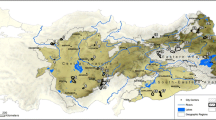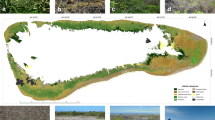Abstract
Papyrus Cyperus papyrus swamps sustain the livelihoods of millions of people, but threats to this habitat have never been quantified formally. Birds are useful indicators of threats that cannot be measured directly. Using satellite imagery classification and habitat associated modelling, we quantify drainage and present International Union for Conservation of Nature (IUCN) Red List assessments for the eight taxa most closely associated with this habitat. We show that, between 1984–1987 and 1999–2001 the areal extent of papyrus declined by 6.7 % from 1,643 to 1,532 km2. Papyrus-specialist avifauna has undergone much greater declines, due in part to fragmentation effects and in part to geographical overlap between areas of highest population densities and areas that have experienced greatest habitat loss. Our assessment does not alter the IUCN Red List status of any full species, but it improves current knowledge of the drivers of their extinction risk. Papyrus gonolek Laniarius mufumbiri should remain at least near threatened, but on the basis of population decline rather than a purported small and decreasing range size, and papyrus yellow warbler Chloropeta gracilirostris should remain vulnerable, but again due to declines rather than on the basis of previous under-estimates of population size. Other species should remain listed as least concern. However, taxonomically, likely specifically, distinct populations of papyrus yellow warbler in Zambia and Kenya are highly threatened and should be listed as endangered and critically endangered respectively. We propose several conservation priorities and discuss means of achieving these in a manner consistent with maintaining the livelihoods of people.



Similar content being viewed by others
References
Abila R, Salzburger W, Ndonga MF, Owiti DO, Barluenga M, Meyer A (2008) The role of the Yala swamp lakes in the conservation of Lake Victoria region haplochromine cichlids: evidence from genetic and trophic ecology studies. Lake Reserv Manage 13:95–104
Akçakaya HR, Ferson S, Burgman MA, Keith DA, Mace GM, Todd CR (2000) Making consistent IUCN classifications under uncertainty. Conserv Biol 14:1001–1013
Aloo PA (2003) Biological diversity of the Yala Swamp lakes, with special emphasis on fish species composition, in relation to changes in the Lake Victoria Basin (Kenya): threats and conservation measures. Biodivers Conserv 12:905–920
Amadon D (1954) A new race of Chloropeta gracilirostris. Ostrich 25:140–141
Bennun LA, Njoroge P (1999) Important Bird Areas in Kenya. Nature Kenya, Nairobi
BirdLife International (2012) IUCN Red List for birds. Downloaded from http://www.birdlife.org on 06/11/2012
Britton PL (1978) Seasonality, density and diversity of birds of a papyrus swamp in western Kenya. Ibis 120:450–466
Butchart SHM, Walpole M, Collen B, van Strien A, Scharlemann JPW, Almond REA, Baillie JEM, Bomhard B, Brown C, Bruno J, Carpenter KE, Carr GM, Chanson J, Chenery AM, Csirke J, Davidson NC, Dentener F, Foster M, Galli A, Galloway JN, Genovesi P, Gregory RD, Hockings M, Kapos V, Lamarque J-F, Leverington F, Loh J, McGeoch MA, McRae L, Minasyan A, Morcillo MH, Oldfield TEE, Pauly D, Quader S, Revenga C, Sauer JR, Skolnik B, Spear D, Stanwell-Smith D, Stuart SN, Symes A, Tierney M, Tyrrell TD, Vie J-C, Watson R (2010) Global biodiversity: indicators of recent declines. Science 328:1164–1168
Byaruhanga A, Kasoma P, Pomeroy D (2001) Important Bird Areas in Uganda. Nature Uganda, Kampala
Carignan V, Villard MA (2002) Selecting indicator species to monitor ecological integrity: a review. Environ Monit Assess 78:45–61
Carpenter SR, Mooney HA, Agard J, Capistrano D, DeFries RS, Diaz S, Dietz T, Duraiappah AK, Oteng-Yeboah A, Pereira HM, Perrings C, Reid WV, Sarukhan J, Scholes RJ, Whyte A (2009) Science for managing ecosystem services: beyond the millennium ecosystem. Proc Natl Acad Sci USA 106:1305–1312
Carswell G (2002) Farmers and following: agricultural change in Kigezi District, Uganda. Geogr J 168:130–140
Collar NJ (2003) Beyond value: biodiversity and the freedom of the mind. Glob Ecol Biogeogr 12:265–269
Engel S, Pagiola S, Wunder S (2008) Designing payments for environmental services in theory and practice: an overview of the issues. Ecol Econ 65:663–674
European Commision (2000) Natura 2000. Managing our heritage. European Communities, Luxembourg
Gichuki CM (2000) Community participation in the protection of Kenya’s wetlands. Ostrich 71:122–125
Howard PC, Viskanic P, Davenport TRB, Kigenyi FW, Baltzer M, Dickinson CJ, Lwanga JS, Matthews RA, Balmford A (1998) Complementarity and the use of indicator groups for reserve selection in Uganda. Nature 394:472–475
Irwin MPS, Turner DA (2001) A contribution to the systematics of the papyrus yellow warbler Chloropeta gracilirostris. Honeyguide 47:201–203
IUCN Standards and Petitions Working Group (2010) Guidelines for using the IUCN Red List Categories and Criteria. World Conservation Union, Gland
Kenyan Wetlands Forum (2006) Rapid assessment of the Yala Swamp wetland. East African Wildlife Society, Nairobi
Kinaro ZO (2008) Wetland conversion to large-scale agricultural production; implications on the livlihoods of rural communities, Yala Swamp, Lake Victoria basin, Kenya. Department of Water and Environmental Studies, Lingköpings Universitet, Linköping
Kruger O (2005) The role of ecotourism in conservation: panacea or Pandora’s box? Biodivers Conserv 14:579–600
Leonard P, Beel C (1999) Two new resident birds in northern Zambia. Bull Afr Bird Club 6:56–58
Mace GM, Collar NJ, Gaston KJ, Hilton-Taylor C, Akçakaya HR, Leader-Williams N, Milner-Gulland EJ, Stuart SN (2008) Quantification of extinction risk: IUCN’s system for classifying threatened species. Conserv Biol 22:1424–1442
Maclean IMD, Hassall M, Boar R, Nasirwa O (2003a) Effects of habitat degradation on avian guilds in East African papyrus Cyperus papyrus swamps. Bird Conserv Int 13:283–297
Maclean IMD, Musina J, Nalianya N, Mahood S, Martin R, Byaruhanga A (2003b) Systematics, distribution and vocalization of papyrus yellow warbler Chloropeta gracilirostris. Bull Afr Bird Club 10:94–100
Maclean IMD, Tinch R, Hassall M, Boar R (2003c) Social and economic use of wetland resources: a case study from Lake Bunyonyi, Uganda. ECM-2003-09, CSERGE, Norwich
Maclean IMD, Tinch R, Hassall M, Boar RR (2003d) Towards Optimal Use of Tropical Wetlands: an Economic Valuation of Goods Derived from Papyrus Swamps in Southwest Uganda. ECM-2003-10, CSERGE, Norwich
Maclean IMD, Hassall M, Boar RR, Lake IR (2006) Effects of disturbance and habitat loss on papyrus-dwelling passerines. Biol Conserv 131:349–358
Maclean IMD, Boar RR, Lugo C (2011a) A review of the relative merits of conserving, using, or draining Papyrus Swamps. Environ Manage 47:218–229
Maclean IMD, Wilson RJ, Hassall M (2011b) Predicting changes in the abundance of African wetland birds by incorporating abundance-occupancy relationships into habitat association models. Divers Distrib 17:480–490
Matthews GVT (1993) The Ramsar Convention on Wetlands: Its history and development. Ramsar Convention Bureau, Gland
Muriuki JN, DeKlerk HM, Williams PH, Bennun LA, Crowe TM, VandenBerge E (1997) Using patterns of distribution and diversity of Kenyan birds to select and prioritize areas for conservation. Biodivers Conserv 6:191–210
Naidoo R, Adamowicz WL (2005) Economic benefits of biodiversity exceed costs of conservation at an African rainforest reserve. Proc Natl Acad Sci USA 102:16712–16716
Owino AO, Ryan PG (2006) Habitat associations of papyrus specialist birds at three papyrus swamps in western Kenya. Afr J Ecol 44:438–443
Owino AO, Ryan PG (2007) Recent papyrus swamp habitat loss and conservation implications in western Kenya. Wetl Ecol Manag 15:1–12
Saito F (2003) Decentralization and development partnership: lessons from Uganda. Springer, Tokyo
Şekercioğlu CH, Daily GC, Ehrlich PR (2004) Ecosystem consequences of bird declines. Proc Natl Acad Sci USA 101:18042–18047
Thomas L, Buckland ST, Rexstad EA, Laake JL, Strindberg S, Hedley SL, Bishop JRB, Marques TA, Burnham KP (2010) Distance software: design and analysis of distance sampling surveys for estimating population size. J Appl Ecol 47:5–14
Tobias JA, Seddon N, Spottiswoode CN, Pilgrim JD, Fishpool LD, Collar NJ (2010) Quantitative criteria for species delimitation. Ibis 152:724–746
van Dam A, Kipkemboi J, Zaal F, Okeyo-Owuor JB (2011) The ecology of livelihoods in East African papyrus wetlands (ECOLIVE). Rev Environ Sci Biotechnol 10:291–300
Vande weghe JP (1981) Avifauna of papyrus in Rwanda and Burundi. Gerfaut 71:489–536
Wetlands Inspectorate Division (2001) Wetlands Sector Strategic Plan 2001–2010. Ministry of Water, Land and Environment, Kampala
Acknowledgments
Fieldwork for this project was part funded by the African Bird Club, British Airways, Royal Geographic Society and University of East Anglia. We are grateful to the Office of the President of the Government of Kenya, the Uganda National Council of Science and Technology for permission to carry out the research. We thank Steven Katungi, Rob Martin, Rowan Martin, Simon Mahood, Richard Moores, Nicodemus Nalianya Johnson Ruhakana and Johnson Tumahairwe for help with fieldwork. Information on the distribution of papyrus-dwelling passerines was provided by Leon Bennun, Achilles Byaruhanga, the late Paul Coopmans and Bob Stjernstedt, Lincoln Fishpool, Bryan Giezl, Pete Leonard, Ara Monadjem, David Moyer, Nicodemus Nalianya, Oliver Nasirwa and Malcolm Wilson.
Author information
Authors and Affiliations
Corresponding author
Rights and permissions
About this article
Cite this article
Maclean, I.M.D., Bird, J.P. & Hassall, M. Papyrus swamp drainage and the conservation status of their avifauna. Wetlands Ecol Manage 22, 115–127 (2014). https://doi.org/10.1007/s11273-013-9292-8
Received:
Accepted:
Published:
Issue Date:
DOI: https://doi.org/10.1007/s11273-013-9292-8




